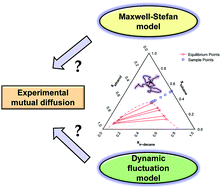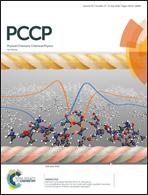A predictive model for the diffusion of a highly non-ideal ternary system
Abstract
Diffusion plays a central part in many unit operations. The Maxwell–Stefan model is the dominant model for both gaseous and liquid diffusion. However, it was developed from the kinetic theory of gases, raising the question of whether it can be extended to non-ideal liquid systems. The dynamic fluctuation model is an alternative model based on the Cussler theory and predicts a smaller thermodynamic influence relative to the linear influence of the Maxwell–Stefan model due to dynamic concentration fluctuations. Since the dynamic fluctuation model, which uses the scaling factor α, had improved performance relative to the Maxwell–Stefan model for a wide range of binary systems, it is postulated that this improved performance should also be observed for a ternary system. In this work, the dynamic molecular fluctuation model was extended to a highly non-ideal ternary system, using the same scaling factor α, through matrix manipulation. Using self-diffusion data measured by NMR, mutual diffusion predictions of the developed model and the Maxwell–Stefan model were compared to experimental mutual diffusion data of the partially miscible system ethanol/toluene/n-decane. It is demonstrated that the dynamic fluctuation model gives improved predictions relative to the Maxwell–Stefan approach, consistent with previous observations on binary systems, showing that the reduced thermodynamic influence of the dynamic fluctuation model is an improvement. In addition, we show that the use of local mole fractions, to account for molecular association, in both the dynamic fluctuation and Maxwell–Stefan models, results in improved diffusion predictions for the ternary system. The results confirm that the dynamic fluctuation model improves predictions of mutual diffusion in liquid mixtures, suggesting a non-linear correction to the thermodynamic correction factor. The results also suggest that that the key assumptions in the Maxwell–Stefan model and its derivation, rooted in the kinetic theory of gases, are not entirely accurate for highly non-ideal liquid systems. The optimum α for the ternary system studied here is approximately 0.45, similarly to the optimum α of 0.40 to 0.80 for a range of binary systems previously studied, suggesting that the use of the α scaling factor, which is grounded in scaling laws theory, is of general validity.



 Please wait while we load your content...
Please wait while we load your content...